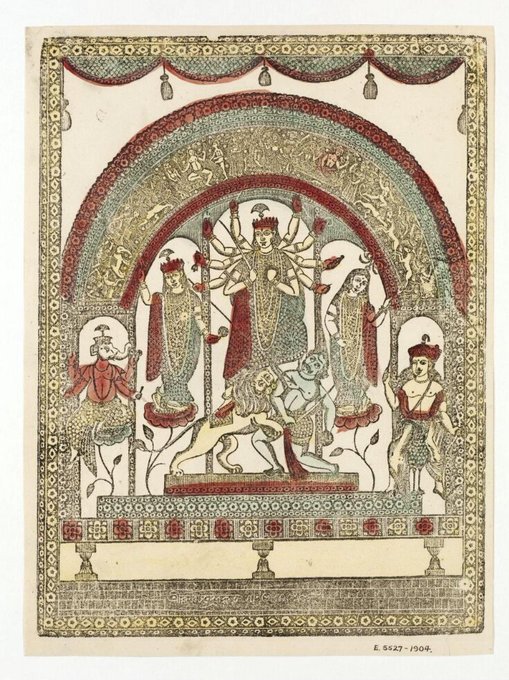woodcut engraving of Devi Durga fighting with Mahishasur
by artist Madhab Chandra Das, 19th -20th century @V_and_A wood engraving lost shin due to lithograph prints appeared in market & had glossy colours & shining
though engraving on wood was more difficult
woodcut tableau depicts Devi Durga Mahishasur mardini flanked by Lakshmi & Sarasvati
just like Durga Puja Mandap
woodcuts became popular as it was cheap & easily available compared to prints
this is by Krishna Chandra of Shobhabazar, c.1860-70 @V_and_A
image showing Indian servants
From "Chambers's History of the Revolt in India" London, 1859 via https://t.co/etImfUNFja
reminded me of description by Fanny Parkes about monthly wages & names of Khidmatgar ख़िदमतगार कारिन्दा ? in her journal Begum Thugs & Englishmen
@DalrympleWill
Together Devi(s) fought with evil forces
Devi Kumari Fighting Asuras (Verso), Folio from Devimahatmya
Painting from Rajasthan, Sirohi, 1675-1700 @LACMA
all devta combined energies thus born various forms of Devi Durga?
Raktabija, presented special challenge. Every time a drop of his blood fell on ground, a clone of demon arose. Devi created a fearsome emanation of herself, Devi Kali. As Kali lapped up Raktabija’s blood, she was able to defeat him
Painting from Guler, 1775-1800 @walters_museum
compare 2 scenes
illustrated Sunday news, 1874, titled "Famine in India: women grinding corn" via https://t.co/etImfUNFja
2nd is chromolithograph of Simpson, 1867? earlier i wrote wrongly as 1862 from @britishlibrary
western's bad knowledge?
chromolithograph by William Simpson, 1862 @britishlibrary painting??
laborious task of grinding corn in India was always performed by women, using 2 large flat circular stones. upper had handle for turning & hole through which corn fell on to lower stone, where it was crushed
Two women working on quern to grind grain into flour. painting dated [between 1800 and 1899?] @ExploreWellcome
it is chakki
Spot-billed or Grey Pelican (Pelecanus philippensis) - c 1800-1804
company painting, Birds
from exhibition at DAG












